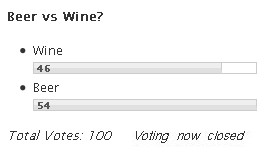 I usually don’t do online, or any other kind, of survey. But, an ad for the Nutriprofile personal nutritional profiling site in the weekend papers caught my eye. It was the accreditation by various academic bodies that caught my eye. Among them, the Universities of Nottingham, Reading, the Institute of Brain Chemistry and Human Nutrition – London Metropolitan University, and Healthspan a dietary supplements company.
I usually don’t do online, or any other kind, of survey. But, an ad for the Nutriprofile personal nutritional profiling site in the weekend papers caught my eye. It was the accreditation by various academic bodies that caught my eye. Among them, the Universities of Nottingham, Reading, the Institute of Brain Chemistry and Human Nutrition – London Metropolitan University, and Healthspan a dietary supplements company.
Admittedly, the presence of the commercial entry in the list, raised my suspicions a little, but we’ve all got to earn a living, so I thought I’d give it a go regardless. It was all fairly straightforward asking about my diet and lifestyle, weight and height, the usual things one would expect from a nutritional survey. The results were emailed to me as a link within about 15 hours. The promise was of a “24-page, scientifically validated, report that tells you how to meet your body’s nutritional needs totally and exactly.” I think they mean completely and precisely but let’s not quibble. Apparently, “The value to your future health is immeasurable.” Well, if it’s a measurable how can they measure it…oh yes, I wasn’t going to quibble.
The report, had it been in printed form, would no doubt have been nice and glossy, with lists and charts in red, amber, and green alerting me to various key areas of my diet and health that need fixing. However, various aspects of the nutritional analysis stood out as rather inconsistent right from the start. For instance, those green areas are meant to represent “adequate”. To many people that word has rather negative connotations implying either just enough or barely enough. Now, anyone taking the report seriously would see the green but read “adequate” and either be confused or feel that they had failed the test somehow and need to fix things. Green I would suggest would mean just fine, not merely adequate. There would be no need to get any more of this and no need to have any less of that.
Then there is the issue of the my fruit and veg intake. Well, I do like my veggies, but I am a meat eater too. I do like fruit, but don’t always get around to peeling the requisite number of citrus items or munching through quite enough apples etc to bring me up to my perfect 5 or more. That said, if we have Brussels sprouts for dinner, brocolli, asparagus or indeed almost any other veg, I generally have bigger portions of those. But, given that I got the green tab for every other aspect of my nutrition (with a couple of exceptions, more on that later), which means enough vitamins and minerals, I cannot quite understand why it matters if I don’t always have specifically five fruit and veg portions. More to the point, if I’ve somehow got adequate intake of vitamins and minerals but I’m not eating enough fruit and veg where are the majority coming from in the first place? One of the major issues with such a survey is that they failed to ask how big are my portions? Surely a big stack of fresh garden peas or runner beans, twice as big as someone else’s meagre portion of cauliflower counts for more not less.
Next up are the omega acids. It’s a trendy buzzword with lots of research grants hinging on it. The trouble is, there is only so much oil fish you can eat in a week unless you’re a real big fish fan and don’t mind the mess and household stench of cooking it more often. Not to mention the bioaccumulated pollutants, such as mercury, which they say are a problem with many oily fish and some of the predatory fish. So, I fall down on that score too. (Maybe I am doomed, after all). Incidentally, why is it we are not usually keen to eat land-based predators but are fine with piscine predators such as shark, swordfish etc? Is it a parasite problem perhaps?
Next, I was flashed amber for several mineral values, which raised my hackles too. Apparently, I have a risk of deficiency for copper (I get 1.14 milligrams, but apparently need 1 .2 mg). Hmmmm. I get 95% of an estimated recommended daily amount and they say I’m at risk of deficiency. How can they tell? Maybe I eat something only rarely that covers the deficit but that wasn’t mentioned in the initial survey.
Then there’s selenium. There is actually no definitive allowance for selenium. It is next to impossible to determine a person’s load of this element let alone figure out whether they have enough or not. We don’t yet know what “enough” is when it comes to selenium. Nevertheless the profile tells me I am at a deficiency risk because I only get 62 micrograms whereas I need 72 micrograms. Again, it’s marginal wouldn’t you say?
Other items on the list are shown as green for adequate, yet reading the figures, I would say rather than being adequate I am actually overdosing on them with my current diet. For instance, I’m taking in more than 1.5 g of phosphorus but their chart tells me I only need half a gram.
Similar, with the dreaded sodium, I’m ingesting 2624 mg, according to my inputs. This figure, incidentally, is far too precise a value for an estimate being given with four significant figures. Regardless, I should only have a maximum of 2400mg (two sig figs). So, I’m a pinch above the recommendation, but they never asked me about my blood pressure and that could be a major factor in whether I’m seriously overdosing on sodium or okay.
Finally, I don’t get enough fibre, what my grandmother used to call roughage, apparently. At a reported 13.4 g (I really don’t know where they get those three significant figures from) as opposed to a recommended 18g. I actually eat a huge bowl of porridge oats most working days, have sandwiches made with wholemeal bread at lunchtime, and generally leave the skins on potatoes, eat brown rice etc. But, more to the point, they didn’t ask me what size are my portions. They also have no idea how precisely I estimated my own intake of any given food. So, while such surveys might be fun and quick to do and can provide useful indicators of problem areas in your diet if you are seriously deficient, I think the detailed results should be taken with the proverbial pinch of salt. Or maybe not, if you’ve got high blood pressure.
I’ve posted my personal results as a PDF on the web, if anyone is interested in comparing their results to mine, I’ll email the link, just let me know.
 News headlines almost always deal in data-free absolutes. Take this recent strapline from an item on Australian news site: Drinking two or more colas a day – whether sweetened with sugar or an artificial sweetener – doubles your risk of chronic kidney disease, according to new research. And, at the time of writing, the media is full of the news that modern antidepressants don’t work, although the actual research papers on which such headlines are based will not be quite so definitive in their conclusions.
News headlines almost always deal in data-free absolutes. Take this recent strapline from an item on Australian news site: Drinking two or more colas a day – whether sweetened with sugar or an artificial sweetener – doubles your risk of chronic kidney disease, according to new research. And, at the time of writing, the media is full of the news that modern antidepressants don’t work, although the actual research papers on which such headlines are based will not be quite so definitive in their conclusions. In the good-old days there was no choice, if you were posh you drank wine, if you were not you drank beer. Same goes for the Beatles-Stones debate. The Beatles were the nice clean-living, fun loving beat combo, whereas the Rolling Stones were the scare-your-mom hairies. But, making the choice between beer vs wine, Beatles vs Stones led to a societal bifurcation, it split us down in the middle, in other words.
In the good-old days there was no choice, if you were posh you drank wine, if you were not you drank beer. Same goes for the Beatles-Stones debate. The Beatles were the nice clean-living, fun loving beat combo, whereas the Rolling Stones were the scare-your-mom hairies. But, making the choice between beer vs wine, Beatles vs Stones led to a societal bifurcation, it split us down in the middle, in other words.

 A panel of eighteen apparently maverick thinkers was charged with coming up with a to-do list for the twenty-first century by the US National Academy of Engineering (NAE). The maverick panel includes such notables as former director of the National Institutes of Health Bernadine Healy, Google co-founder Larry Page, geneticist and businessman
A panel of eighteen apparently maverick thinkers was charged with coming up with a to-do list for the twenty-first century by the US National Academy of Engineering (NAE). The maverick panel includes such notables as former director of the National Institutes of Health Bernadine Healy, Google co-founder Larry Page, geneticist and businessman 

